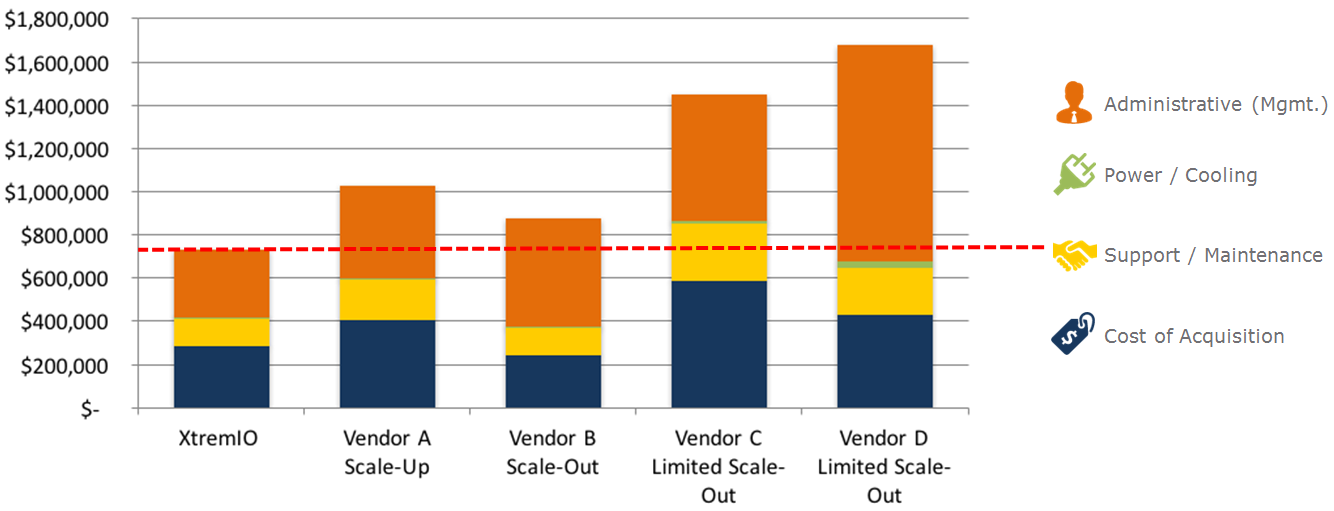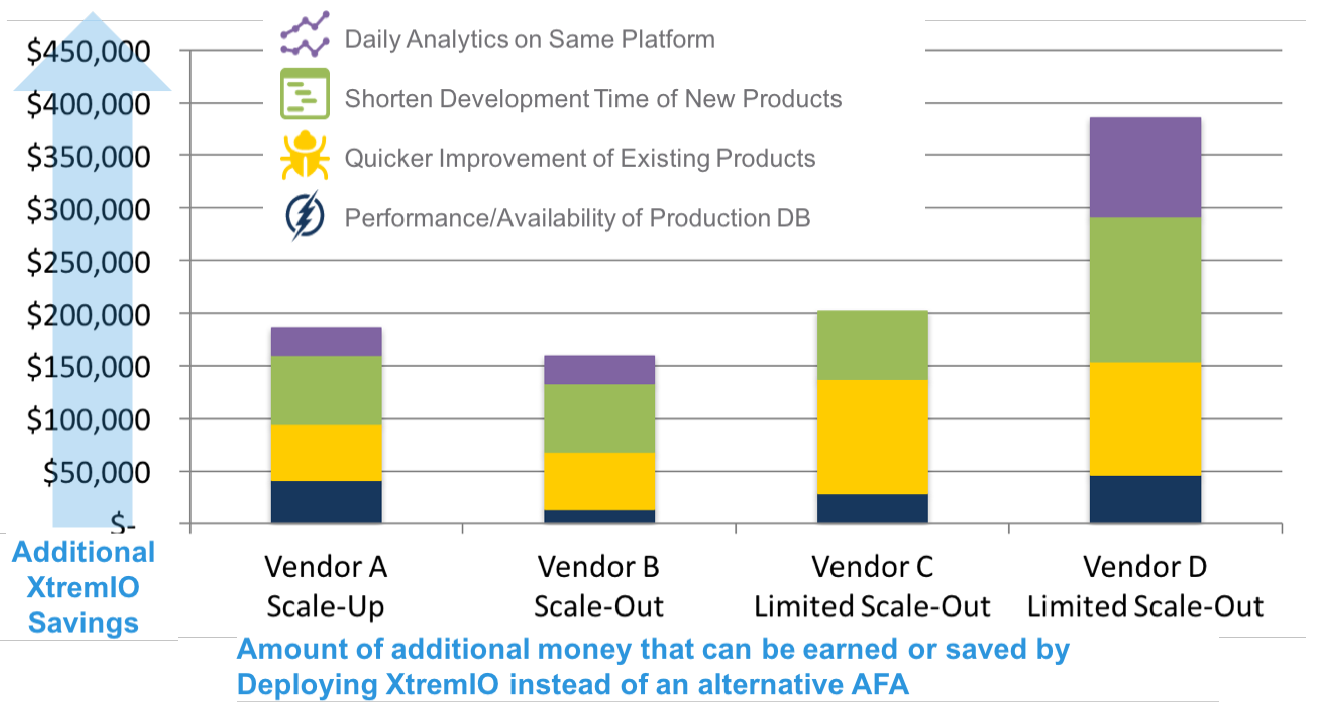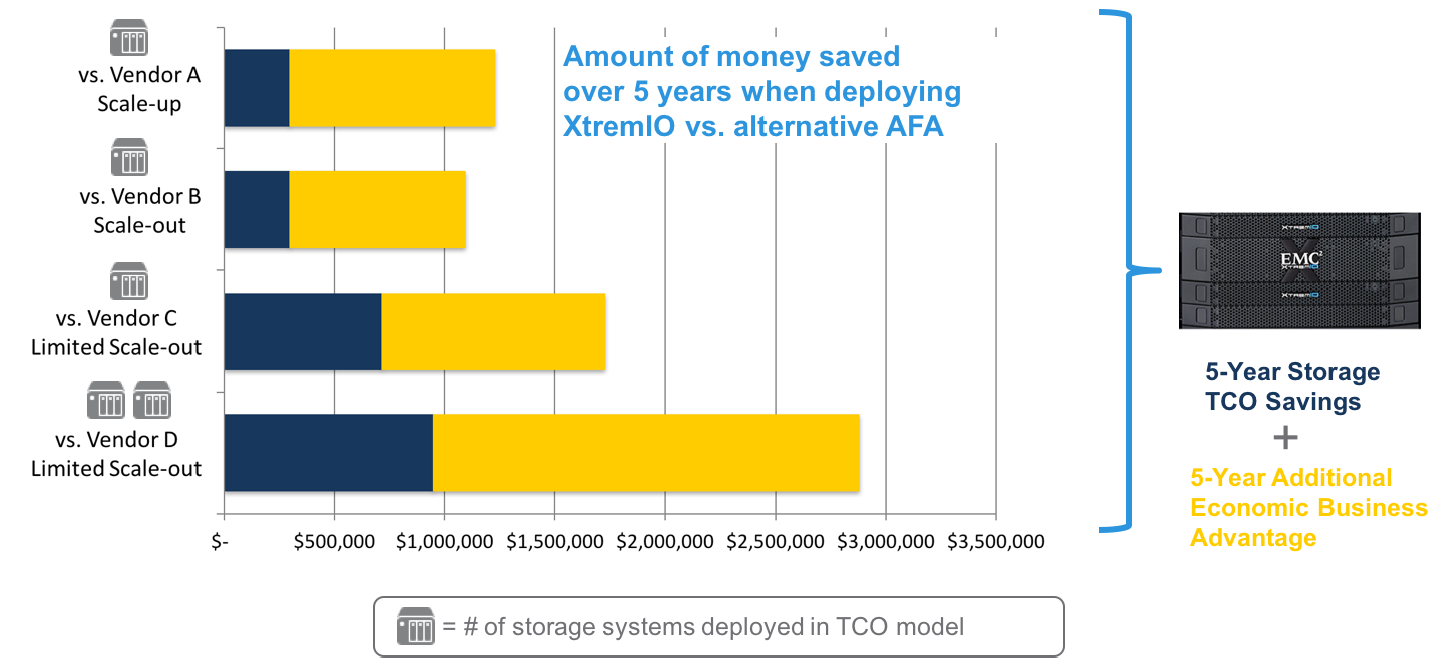It’s 2016 – the “Year of All-Flash” for primary storage. The market, however, is crowded with all-flash arrays from many different vendors. The design decisions and tradeoffs made by these vendors can result in very different all-flash system capabilities, and ultimately, tradeoffs in economic benefits to the organization.
So, how does one choose the best for an organization? Leading analyst firm ESG have published a new TCO study to help businesses understand the pros and cons of some of the leading all-flash arrays on the market today.
The research builds on an earlier study measuring the 5-year TCO and business impact of consolidating workloads with an EMC XtremIO all-flash array at a mid-market software development company generating $54M in annual revenue. It showed XtremIO offering a 5-year storage TCO saving of $2.8M along with an additional $3.2M in business impact, for a total of a $6M advantage.
The new study uses the same model to compare the TCO of XtremIO to four other market leading all-flash array offerings from different vendors. Although EMC has launched a complete portfolio of flash solutions with VMAX All Flash, Unity and DSSD in 2016, this report is focused only on XtremIO due to the fact that XtremIO was examined in the previous study.
ESG anonymized the companies, referring to them as Vendors A through D. Each provided significant TCO and economic business advantages over the traditional storage systems that ESG analyzed in 2015. However, ESG found that all of these all-flash offerings were designed to optimize a few strategic advantages, and did not offer the entire spectrum of benefits that XtremIO did.
For example, Vendor A was designed to be simple to administer, simple to deploy, and space-efficient. However, the active/passive scale-up design, traditional data protection, and redirect-on-write snapshot technology meant more hardware had to be deployed to satisfy the requirements, and the process of dealing with copies of data was simplified, but not optimized.
Vendor B offered a very economical scale-out design using commodity hardware and advanced QoS, but also had to deploy more hardware, and limited redirect-on-write read-only snapshots meant that workarounds had to be employed to manage copies of data.
ESG found that the flash array by Vendor C provided good performance. However, the need to integrate an external storage virtualization solution to provide copy-on-write-based data services greatly reduced its performance capabilities and increased the complexity of the solution.
Finally, Vendor D lacked the management capabilities of the other products and could not provide the predictable performance that is required in a modern data center. The lack of copy data management functionality caused ESG to suggest that it would significantly lengthen the time taken to create, manage and roll forward/back copies for test, development, QA and go-live operations.
The net result?
As ESG explained, the ability to satisfy the requirements of the organization with less physical hardware generally meant lower costs for acquisition, support and maintenance, and power and cooling. The simplified management and monitoring, along with the zero impact, easy-to-use virtual copy and refresh/restore capabilities of XtremIO, helped to minimize storage-related administrative costs.

In addition to offering the lowest storage TCO among the all-flash vendors, ESG also found that XtremIO delivered the largest economic advantage to the modeled software development organization over the 5-year period. When compared to most of the other four vendors, the XtremIO solution would be expected to provide more predictable performance and quicker recovery for the production database, resulting in increased customer retention, fewer lost sales, and the ability to benefit from the results of running daily analytics on the same system.
Among the all-flash arrays ESG reviewed, XtremIO is the only one to offer truly advanced copy technology with XtremIO Virtual Copies (XVC) and integrated Copy Data Management (iCDM). These greatly simplify and accelerate the job of providing copies of data for test, development, QA, and go-live testing with little to no impact to the production database. ESG found that the abilities to quickly roll-forward and roll-back changes to these copies result in shorter development cycles for new products and quicker patching and enhancements to existing product lines. This faster time to product revenue streams and increased customer retention for existing products help further justify an investment in XtremIO.

Combining the storage TCO benefits and additional business impact, ESG reveals that the modeled organization could expect to realize approximately $1-3 million more over the 5-year period by deploying XtremIO rather than any of the other four all-flash arrays.

Get the XtremIO vs. other all-flash arrays TCO study here for the thorough analysis conducted by ESG. Enjoy!
